Fashion & Textile History Gallery
December 3, 2009 – May 11, 2010
Online Exhibition
Rules of fashion dictate how women should dress to suit the time of day, season, social
occasion, or activity. They influence colors, materials, necklines, hemlines, and
other elements of fashionable dress. Sometimes they operate as a flexible set of guidelines,
at other times as strictly observed etiquette. Since the early nineteenth century,
women's clothing has been primarily divided into daywear and eveningwear. Night & Day explored the evolution of the rules that have governed fashion over the past 250
years, revealing when they have been at their most extreme or so relaxed as to be
barely perceptible.
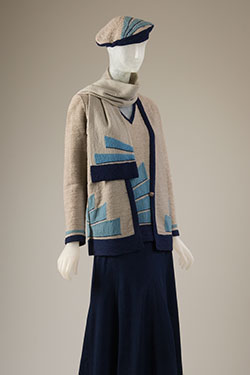
Sportswear ensemble, navy blue, turquoise, and ecru wool, c.1929, France, museum purchase,
2009.15.7
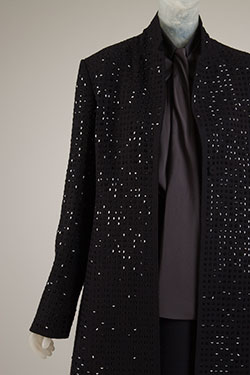
Calvin Klein (Francisco Costa), ensemble, black wool, black crystal paillettes, grey
silk, Fall 2008, USA, gift of Calvin Klein Inc., 2009.30.1
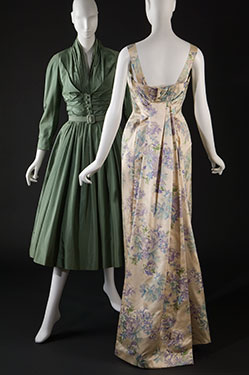
Left: Christian Dior New York, afternoon dress, sea green silk taffeta, circa 1952,
France, gift of Mrs. Helen Ziegler, 86.30.1. Right: Christian Dior, evening dress,
printed ivory silk satin, spring summer 1956, France, gift of Mrs. Michael Blankfort,
76.233.2
Throughout most of the eighteenth century, women's fashion was categorized not according to the time of day, but rather by the degree of formality and the setting
in which a garment was worn. By the end of the eighteenth century, new rules had begun
to emerge, especially in France, where the Revolution of 1789 resulted in a new social
order. Dressing according to the time of day and its associated activities and social
occasions became the norm. In general, long sleeves and high necklines were meant
for day and short sleeves and low necklines were considered appropriate for evening.
These rules remained in force throughout the nineteenth century and beyond.
Dresses in plain wools and cottons were appropriate for mornings at home. For afternoon
visits and promenades, women wore dresses that featured more luxurious fabrics and
ornamentation. Different types of evening dresses were worn for entertaining at home
or for going to the opera or a ball. Dinner dresses signaled the break with daytime
fashion, but tended to be more demure than formal evening gowns. Embellished silk
dresses prevailed for evening.
After World War I, fashion permitted a slightly more relaxed set of guidelines. In
the 1920s, knit sportswear became fashionable as informal daywear. Cocktail dresses
were another 1920s innovation. However, fashions of the 1950s demanded a strict set
of rules corresponding to the renewal of formal society after World War II. Couturiers
like Christian Dior created a panoply of styles that revived silhouettes and dress
codes from the nineteenth and early twentieth centuries.
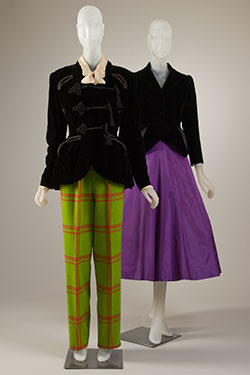
Left: Elizabeth Arden (Antonio Castillo), day ensemble, green plaid wool, black silk
velvet, ivory silk chiffon, circa 1946, USA, gift of Doris Duke, 72.81.6. Right: Charles
James, dinner ensemble, purple silk taffeta, black silk velvet, 1947, USA, gift of
Beatrice Simpson, 77.230.1
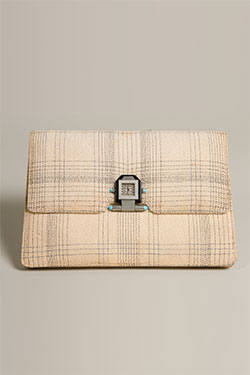
Clutch handbag, cream and black wool with metal watch, black enamel and faux turquoise,
circa 1933, USA, gift of Fernanda Munn Kellogg, 76.196.161
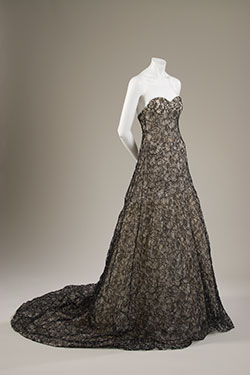
Rochas (Olivier Theyskens), evening dress, black chantilly lace with black and silver
cellophane embroidery, spring 2004, France, gift of Maison Rochas, 2007.53.2
The line dividing daywear and eveningwear began to disappear in the 1960s, as dress
codes disintegrated. Yves Saint Laurent introduced his version of an evening pantsuit
in 1966, and by the 1970s, most fashion rules had been broken. Contemporary fashion
adheres to very few traditional rules and promotes loose definitions of daywear and
eveningwear. Although true day suits, cocktail dresses, and evening gowns still exist,
there are many permutations of these and other styles that cannot be easily defined.
Organized by Molly Sorkin, associate curator of costume.


